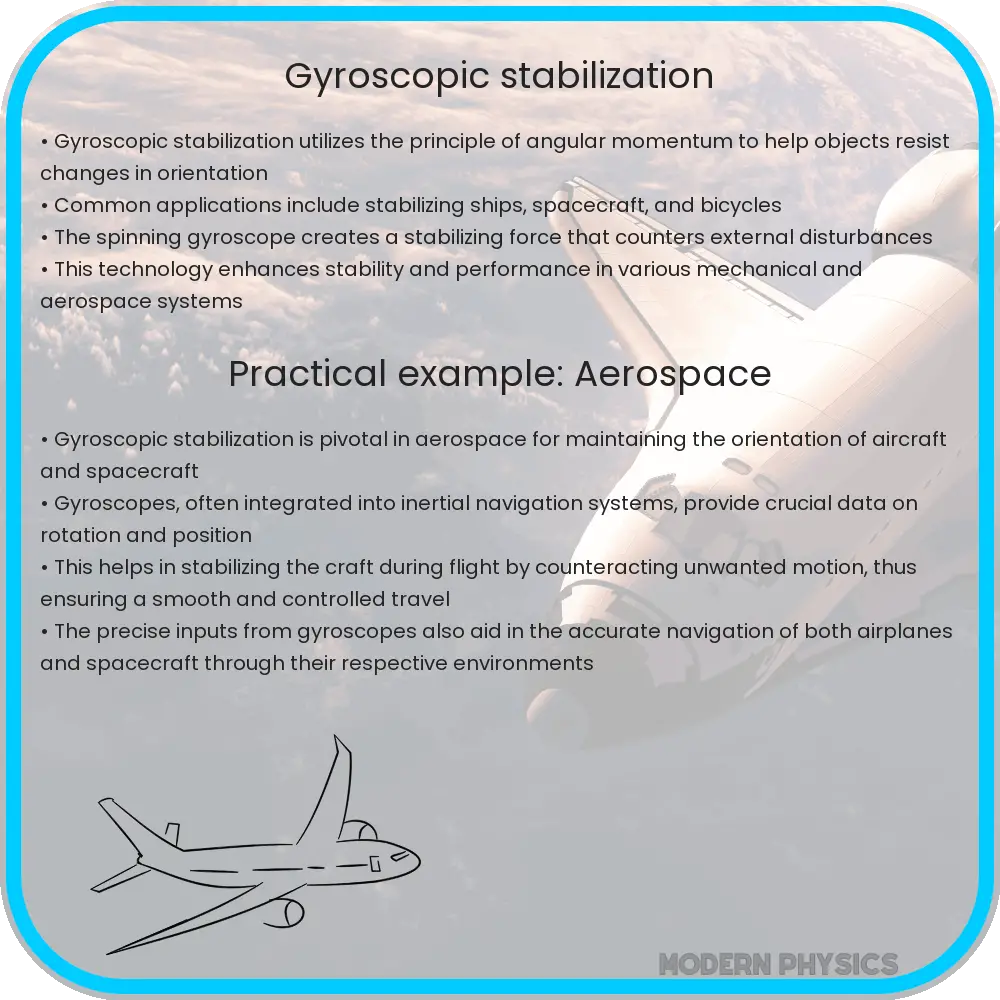Gyroscopic stabilization is a physics and engineering principle aiding orientation in devices like smartphones and spacecraft, based on angular momentum conservation.

Understanding Gyroscopic Stabilization
Gyroscopic stabilization is a fascinating and crucial concept in physics and engineering, integral to the operation of various devices and vehicles ranging from everyday gadgets like smartphones to advanced transportation systems like spacecraft. It revolves around the principle of a gyroscope, which is a device that helps measure or maintain orientation based on the principles of angular momentum. In this article, we explore the fundamentals of gyroscopic stabilization, how it works, and its applications in different fields.
What is a Gyroscope?
A gyroscope is a spinning wheel or disk whose axle is free to take any orientation. While this description might seem simple, the physics underlying its operation is quite profound. The key aspect of a gyroscope is its ability to maintain its rotational axis despite external disturbances, which is due to the conservation of angular momentum.
The angular momentum (L) of an object is given by the equation L = I * ω, where:
- I is the moment of inertia, the measure of an object’s resistance to changes in its rotation,
- ω (omega) is the angular velocity, or the speed at which the object rotates.
According to the law of conservation of angular momentum, if no external torque acts on a system, the total angular momentum of the system remains constant. This principle allows a gyroscope to resist changes to its orientation.
How Gyroscopic Stabilization Works
The stabilization effect of a gyroscope comes from its ability to counteract external forces due to its angular momentum. When an external torque attempts to tilt the spinning axis of a gyroscope, the gyroscope responds not by tilting in the direction of the force, but perpendicular to both the direction of the force and the axis of rotation. This response is dictated by the precession movement, and can be described by the equation:
τ = L * α, where:
- τ (tau) represents the torque applied,
- L is the angular momentum,
- α (alpha) is the angular acceleration.
This perpendicular resistance is what allows gyroscopes to stabilize objects against tilting or flipping, making them invaluable in numerous practical applications.
Applications of Gyroscopic Stabilization
The uses of gyroscopic stabilization are diverse and critical in many modern technologies. Some key applications include:
- Aerospace: In spacecraft, gyroscopes are used to maintain orientation in the three-dimensional space where landmarks are absent.
- Transportation: Modern ships use gyroscopic stabilizers to counteract the rolling motion induced by waves, improving the stability of the vessel.
- Consumer Electronics: In smartphones and cameras, gyroscopes help stabilize images and detect orientation for user interfaces.
This unbelievable utility of gyroscopic stabilization shows how principles of physics are applied to solve real-world problems and enhance the functionality of various technologies. By ensuring stability and orientation, gyroscopes play a silent but crucial role in many aspects of modern life.
In the next section, we will delve deeper into the technical dynamics of gyroscopic effects and explore further how this fascinating device continues to impact technological advancements.
Technical Dynamics of Gyroscopic Effects
The gyroscopic effect is not just about maintaining orientation but also involves fascinating dynamics that reveal more about the laws of physics. When a gyroscope spins, it creates a scenario where any force applied at one point of the rotation results in a movement at a perpendicular angle from the point of application. This behavior is known as gyroscopic precession, a fundamental phenomenon in the behavior of rotating bodies.
For example, if a force is applied to the top of a spinning bicycle wheel, the wheel will not simply tip over in the direction of the force. Instead, it will start tipping sideways, perpendicular to the original force. This seemingly counterintuitive movement is due to the torque generated by the spinning mass of the wheel and is described by the right-hand rule: if you curl the fingers of your right hand in the direction of rotation, your thumb will point in the direction of the gyroscopic effect.
Challenges and Advancements in Gyroscopic Technology
Despite its advantages, implementing gyroscopic stabilization presents challenges, primarily relating to the environmental factors and the scaling of the system. Larger gyroscopic systems, such as those used in ships, require considerable energy and robust mechanisms to sustain significant angular momentum. Additionally, external factors like temperature changes, mechanical stress, and wear can influence the effectiveness of a gyroscope.
Innovations continue to enhance the precision and durability of gyroscopes. For instance, developments in microelectromechanical systems (MEMS) have allowed for the creation of small-scale gyroscopes used in consumer electronics. These advancements contribute to more precise measurements and more reliable performance in a range of applications.
Conclusion
The principles underpinning gyroscopic stabilization illustrate a beautiful piece of physics and engineering that beautifully intertwines theoretical principles with practical applications. From enhancing the stability of vehicles and vessels to improving the accuracy of technological devices, gyroscopes demonstrate the profound impact of angular momentum in motion stability.
The continuous evolution of gyroscopic technologies, spurred by both theoretical insights and practical challenges, promises further innovative applications. As gyroscopes become smaller, more efficient, and more sensitive, their integration into new areas of technology and everyday devices will likely expand, making them even more integrated into the fabric of modern life. Understanding the core physics behind gyroscopy empowers us to appreciate the sophisticated interplay between forces that stabilize and orient our tools and vehicles in an ever-changing environment.
